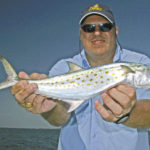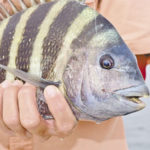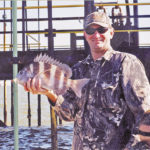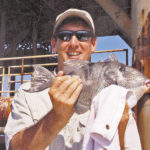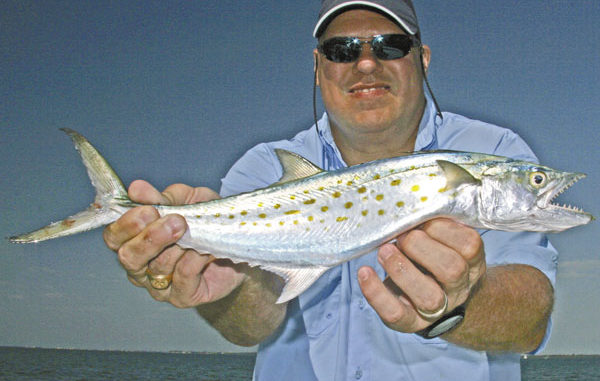
If you’re the type of guy who couldn’t even catch fish with a gill net in the Boat Show tank, head down to East Bay this month, where several species are dying to make you look like the next Bill Dance.
Doc’s brother, Toby, seemed perplexed as he chatted with Pelayo’s brud-n-law Zach, in from Atlanta for Mardi Gras. Toby’s face contorted and his eyebrows scrunched as he asked Zach again and again: “East Bay? Sure it’s East Bay? Why on earth East Bay — especially this time of the year?”
Zach shrugged, mumbled and pointed toward us.
“Because it’s some of the hottest fishing in coastal Louisiana — that’s why!” I huffed at Toby.
“And especially at this time of the year!” added Pelayo. “Heck man, remember when By HEK and his buddy Dr. Royce Henry wanted to really load up in late winter, they’d head for East Bay and load up box after box with white trout? Besides, East Bay’s dozens of rigs and wells give you great fishing with probably the shortest open-water ride along our coast.
“Water drops off fast when you enter East Bay from Joseph’s Bayou. This also lets you fish fairly comfortably with up to 12-knot winds or so because you’re not really that far from a lee shore. And up to the rig hook-up, you’ve been mostly in the protected river. The place has a lot going for it, my man.”
Toby chuckled.
“Man, just hadn’t heard of anything like that lately,” he said. “Heard of some good snapper limits out of East Bay this summer, though. Capt. Devlin Roussel from Reel Peace says it’s the best place he knows for easy limits of lane snapper.
“Well, anyway, we’re heading down to Doc’s houseboat tomorrow too, but were staying close by. They say they’re tearin’ up the specks in Hospital Bay and Yellow Cotton Bay, in the deep holes, you know. Like they always do in late winter.”
“I’d rather reel in a snagged strand of millfoil!” Pelayo snorted as Toby flinched. “They fight harder than those little winter specks y’all go after. Anyway, we’ll compare boxes tomorrow evening, and see who’s got the most, and biggest. During our shallow-water, winter fishing trips, we don’t have to worry much about limits.”
“And we load up on the best-eating fish!” I added.
White trout and bull croakers aren’t like they were 30 years ago, but they’re definitely making a comeback around the shallower rigs (and jetties) near the mouth of the river. But mainly, we knew sheepshead would be in their ravenous spawning mode, swarming around rigs and wells in the waters from 12- to 50-foot depths in East Bay, as they swarm around all such structures off the Louisiana coast in late winter/early spring, when they can be hauled aboard practically at will on anything shrimp-tipped, even on the end of slaughter poles, as some commercial fisherfolk have lately learned.
Puppy drum, winter Spanish mackerel (generally smaller, more tightly schooled than the ones you run into at shallow rigs during spring and summer) and mangroves would also make the scene, we’ve learned, as would chunky winter pompano. East Bay is one of the few places where you’re almost guaranteed to catch a few, especially in late winter. Back when the Saints had a good kicker (Charley Durkee), pompano fishing was a wintertime tradition in these parts.
But I guess Toby didn’t want to hear about that either.
“As delicious as the less criminal forms of sin,” was how Mark Twain, after sampling pompano on a visit to New Orleans, described their flavor. “Perhaps the best fish in the Gulf,” rhapsodized The Times Picayune Creole Cookbook, circa 1911, about sheepshead. “This fish is delicious in any of a wide number of modes of preparation.”
The cookbook also spoke well of the locally scorned (nowadays) Spanish mackerel: “A delicate and delicious fish far superior to any mackerel in the world — on equal footing with the pompano.”
I was indulging Toby with a reverie on the glories of winter (shallow) rig fishing, explaining how it’s the only time of year you’re absolutely guaranteed to fill some boxes with delicious fish, when the racket started. Come Mardi Gras week, and you expect a hellacious racket at Doc Fontaine’s Bourbon Street bungalow. But it usually issues from the balcony. This uproar came from the corner of the dining room. Pelayo was grinning crazily as he rushed up and jerked my shoulder, spilling most of my drink — and much of it on Priscilla, no less!
She shrieked, jerked back and glowered while I shrugged and pointed at Pelayo, who also shrugged, then blurted: “It’s Eddie! He’s fired up!” and pointed behind him.
Some of the wives huddled in the corner near the dining table. They whispered, arched their eyebrows, rolled their prettily made-up eyes and scrunched their Mardi-Gras painted faces, the whole while pointing toward our old Tigertown chum, the manic Eddie Fleeks. A couple of Doc’s famous Long Island Teas, and it always happens. As if many of them had behaved like Tigertown was a convent! HAH!
As he bulled through the crowd toward us, Eddie’s face had that famous, malicious sneer.
“A joke!” he blurted while panting. “So I’m hearing all these numbers coming from Doc’s nephews and their friends over in the corner,” he gasped while pointing behind him. “I’m hearing about all these ‘scores’ — 115. 120, all kinda scores! Meanwhile I notice they’re all showing each other stuff on their Blackberries! So me, I figure one of ’em’s a bookie! Right? And hey! I want in on the action!
“So I run over there, and see they’re showing each other pictures of some deer on their Blackberries from some game cams — and that’s what all these freakin’ numbers were all about! Some kinda scoring system for deer horns!
“And they’re all ‘braggin about: ‘I let him walk. I LET HIM WALK!’ What on earth’s happening down here?!
“Then that Spencer guy shows a picture of a redfish he caught with a freakin’ flyrod — and RELEASED!! Thing went 8 pounds, he said. Woulda made an awesome courtbollion, fillets on the half shell — you name it! So this guy who lets deer walk, releases the freakin’ redfish!”
Eddie’s face was crimson, and spittle dribbled from his chapped lips. Finally he finished and stood panting. Then he rushed over to the table with the food and grabbed his platter of venison fajitas.
“Score? So what’s THIS ONE SCORE !” he roared while looking around at all the frowns and raised eyebrows.
Then he ran over to the gents in the corner, thrusting the platter in their faces.
“Know what this one SCORED?! I don’t have a freakin’ clue! His spikes mighta measured 4 inches. But look how little’s left! So he certainly SCORED pretty high tonight, right?! Pretty good SCORE — just ask everybody who dove into this platter the minute I brought it in!”
Spence and his buddies were managing to keep their cool, nodding vacantly with bent smiles as Eddie blustered and covered them with spittle.
“And oh!” he flared again, “just so you guys know. Tomorrow we’re going out fishing, and we’re gonna fill several BOXES! Heard that? BOXES!!!”
“Holy moly!” Pelayo laughed. “Eddie’s hitting all the right notes, ain’t he? Bragging about boxes of meat-fish nowadays rivals shootin’ meat-deer. Eddie! You’re on a roll, podnuh!” Pelayo roared while giving a thumbs up.
“Heck man!” Eddie looked over, finally laughing himself. “I shoulda stayed in Boston! All this stuff sounds like the drivel I heard from hunters and fishermen up there!”
After our Tigerland glory years, Eddie had moved to Boston for a job, returning after two divorces and one disbarment, we heard.
But he was right about the “boxes.” We’d be catching mostly bulky fish and without limits. “Boxes” are thus easily filled, and showed off, and bragged about. The trick is to lay the pompano on top, over all the sheepshead and drum. Not that the latter aren’t delicious themselves. But most people don’t regard them as sightly — until they’re on the dinner platter.
Next morning we entered the river from The Jump to find a 10-knot breeze and coolish temperatures — perfect conditions for a fogless fishing trip down here during this often fog-shrouded time of year. We cleared the mouth of Joseph’s Bayou, and followed the poles into the bay, grateful for a shallow-draft 22-foot boat, as this area silts up quickly and only the crewboats can keep up with the location of the deepest channel after the latest dredging.
We stopped at a structure in 20-foot depths, perfect for evading those pesky red snapper and grouper, so common in the deeper East Bay rigs, but whose size and number limits nowadays usually mean an exasperating marathon of catch-and-release (and later usually death) when fishing deeper water.
As usual, especially this time of year, the water was murky on the surface, but the prop wash showed the green slightly underneath. Even better, the slack tide inside meant a slack current out here; hence our baits and jigs would stay close to the beams, where the fish tend to hang out, especially on the upcurrent side of the structure.
Recalling the previous year’s trip to Sandy Point for similar fishing, Zach was frantic to get his bait in the water. He cast his shrimp-tipped (small-hooked, as befits pompano mouths) double shad rigs to the corner of the rig, and started letting out a little line. Pelayo followed suit, casting to the opposite corner.
I watched Zach reel in his slack. He felt pressure — and reared back as his medium spinning rod doubled over.
“Whoo hoo!” he bellowed while cranking away at his spinning reel upside down, a Zach specialty, regardless of our frequent admonitions. “Just like last year!” he whooped.
“Sure is!” Pelayo yelled from the bow as he raised his bent rod overhead. Zach’s fish hit the surface, and the tell-tale yellow fins and shiny body instantly identified his prey. “Yep, we’re on ’em!”
I reached for the net. We take no chances on losing pompano while lifting them on board. Hence the net. Zach beamed from ear to ear as did Pelayo, who actually flipped aboard a nice Spanish mackerel.
Pompano are crustacean — not fish — eaters. So forget any lure that mimics a small fish. Jigs heads (with the smallest hook available) are best, but always tipped with shrimp — always.
I dropped the jig about 8 feet down. Bump-bump came the tell-tale nibbles. I jerked up.
“They’re here!” I howled as my rod dipped, and I started cranking.
This sucker was battling it out, too. He stripped off line in long muscular lunges typical of a sheepshead. And sure enough, after a hearty battle (that no dozen of Toby’s lethargic, scraggly winter specks could approach) I swung aboard a 3-pounder. For this frantic type of fishing, we like 30-pound mono shock leaders, about 3 feet long, atop the jigs, so we can reach down and swing these babies in, one after another.
On my next cast, my rod was almost jerked from my grasp, so I knew it was a Spanish. Pompano and sheepshead (and triggerfish) all nibble. Spanish (and bluefish) whack it and zoom off, often with your whole rig. Fluorocarbon leaders hold up better than mono to their teeth, but they’ll make off with a few jigs on every trip out here.
I chunked my sheepshead in the quickly-filling box as Eddie swung aboard a prized triggerfish, which usually inhabit slightly deeper waters. Alas, during winter, all fish seem to move in closer — which is why Zach was now holding up a small grouper.
“What’s this?”he frowned.
“Grouper,” snapped Eddie. “Throw him back. Gotta be 22 inches — he’s barely 18, I’m guessing.”
And back went the delicacy, while Pelayo swung aboard another chunky sheepshead, swinging the creature with its extended spines inches from my head.
“WHATCHIT!” I howled. “Wanna put my eye out!”
I was just flipping the bail when … “WHO-AH!!”
Zach was latched on again.
“AHHH! AHHH!” he grunted.
“He’s got a double, I bet!” Pelayo roared, as Zach pumped away — backwards and upside down.
I turned from Zach’s spectacle in response to Eddie’s excited “yes-YES!!” to see him reach down from the stern and swing aboard a double on white trout.
“Every year we’re catching more of these!” he beamed while holding them up for our admiration. “I cast away from the rig, let it sink to the bottom and jigged it in slowly — just like we used to catch ’em out here during our Tigertown glory days,” he smirked.
I was still looking at Eddie and on my second reel crank when — WHAM! — a vicious strike almost jerked the pole from my grip.
“Another Spanish here!”
He zoomed off on a surface run. I had him halfway back when another hit the line at the swivel and cut it. Happens often. But I was re-rigged in seconds with a ½-ounce jig head tipped with shrimp. I tossed it out, and it seemed to make it past the swarming sheepshead because I felt it tap the bottom. I just reeled in the slack when, “No, not a snag!” I wailed.
Then my rod bucked.
“Not a snag indeed!” Eddie yelled from the bow.
This sucker felt big, heavy, powerful but not as frantic as a typical sheepshead.
“I need the net for this one, guys!”
Soon a 6-pound puppy drum (ideal for grilling) was flopping in the ever more rapidly filling box.
And so it went, literally non-stop as we fished one rig and two wellheads. Sheepshead predominated with many Spanish, pompano, white trout, drum and two triggerfish adding variety. For the heck of it, on the ride back upriver, we transferred the fish from the 120-quart box to three 48-quart boxes for the principle of the thing.
Back at Doc’s houseboat, we were quick to point out that Toby and his chums had barely filled one such box.
